|
Tamiya's 1/48
scale P-51B
"Goodbye Mickey Mouse"
by
Jonathan Strickland
|
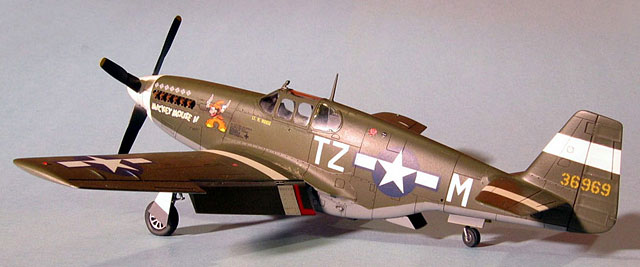 |
|
North American P-51B
Mustang |

Tamiya's
1/48 scale P-51B Mustang is available online from
Squadron.com
Len Deighton is among my favorite novelists. That
being said, “Goodbye, Mickey Mouse” is probably my least favorite of his
books that I have read. It is still a delightful read and has some well
researched descriptions of Mustangs and aerial combat in World War II
mixed with angst, relationships, sex, and all that other stuff that is
supposed to “sell” a novel. When I recently read “Goodbye, Mickey Mouse”
for the second time, I knew I had a good idea for a model.
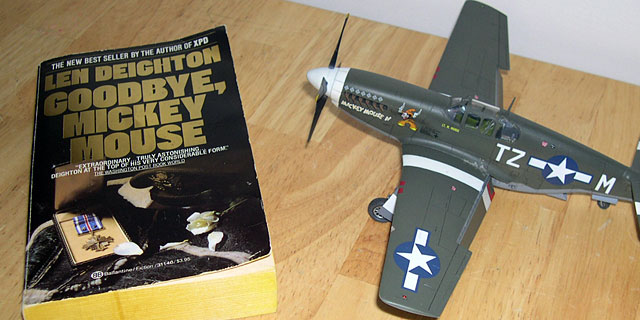
As the story goes, the 199th Squadron of the 220th Fighter Group of (one
can only assume) the 8th Air Force welcomes a new pilot (Capt.
Fairbrother). He is placed into blue flight under the command of Lt.
Mickey Morse. Although the jacket of each printing I have seen claims
the setting to be “the winter of 1944-45” the story actually takes place
a year earlier, and the 199th has just finished transitioning from the
P-47 Thunderbolt to the P-51 Mustang. Morse’s “Mickey Mouse II” is
described well in the book, and since he is the hero of the story, I
chose to model his plane.
I decided to approach this project from two angles. First, what if this
was a true story? How would “Mickey Mouse II” have looked were it an
actual P-51B from WW II? And second, what if Hollywood decided to make a
movie from the novel? How would “Mickey Mouse II” have to look in order
to get it right?
Since the time frame is late 1943 – early 1944 one
can instantly determine what scheme “MM2” would have carried – Olive
Drab over Neutral Gray with all of the required white ID stripes and a
white nose band and spinner to boot (the overspray on the prop blades is
intentional, btw). The colorful rudders and noses did not enter the
scene until the Spring of 1944, so it would be too early for
checkerboard noses and bright blue tails at this point. This was to my
advantage since if it were later in the war I would have to make up
interesting squadron colors and patterns, and (quite frankly) all the
good ones were used by the real fighter squadrons from WW II.
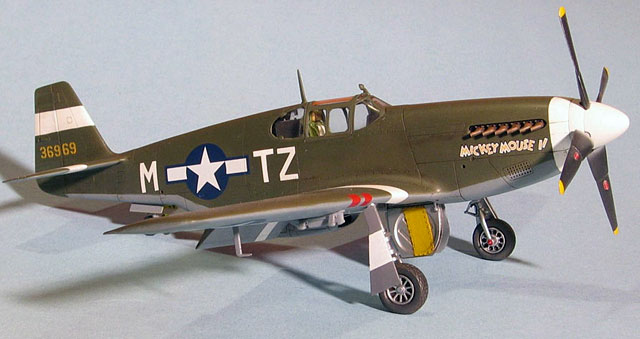
Here are some of the mentions of MM2:
“The aircraft smelled new with it’s mixture
of leather, paint, and high octane fuel. On it’s nose a brightly
painted Mickey Mouse danced, and stenciled in yellow, under the
cockpit, was the name of it’s regular pilot: Lt. M. Morse.”
“… he closed the side panel.” (shucks, no
Malcolm hood)
“MM’s Mickey Mouse II … featured the carton
rodent toting six guns and a ten-gallon hat.”
"Madigan had a can of paint and a brush
ready so that they could get shots of the crew chief painting
another swastika on the nose of his plane.”
Where was I going to find the furry animated icon
dressed up as a cowboy? A simple Google search supplied the answer. As
it turns out, ole Micky starred in a short called “Two Gun Mickey” back
in 1935. I was able to find several pieces of art on the net related to
“Two Gun Mickey”, including a movie poster. This proved to be a valuable
find as the font used for the title happens to be the exact font used on
Maj. George Preddy’s last P-51D (“Cripes’A’Mighty). I quickly gathered
some material and rushed it off to a well known decal maker who has
since stopped taking custom orders (nudge nudge) and he made the decals
you see in the pictures.
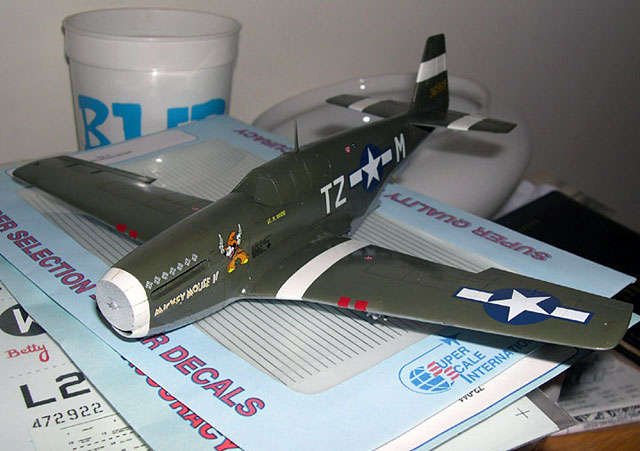
I actually had a mishap with one of the “Mickey
Mouse II”s but was saved instantly by the extra one already provided on
the sheet. I put a “Mickey Mouse II” on the right side of the nose as
well, in case we had to use the starboard side for any shots in the
“movie”. The kills and the name under the cockpit were easy enough
(although, in hindsight, simple white swastikas may have looked better).
But what about the codes? A plane with the name “Mickey Mouse II” and a
pilot who’s name was Mickey Morse simply had to have the individual
letter “M”. And since the 199th Sqdn is ficticious, I decided to give
“MM2” ficticious squadron codes as well. I searched a data base of WW II
USAAF squadrons on the web and was able to determine that the codes ‘TZ”
were not used by any US squadron in WW II. The serial number is
arbitrary but is likely the serial number of an actual P-51B. National
insignia came from spare decal sheets.
As for the build I do what I normally do, OOB
except for seat and exhausts from Ultracast. I did modify the wings to
reflect a WW II P-51B-1. First, I removed the colored lights from the
lower left wing. I also filled and then sanded most of the panel lines
in the wings. P-51s had this done in WW II and then the wings were
painted silver (this includes the Duraluminum or “Natural Metal”
Mustangs).
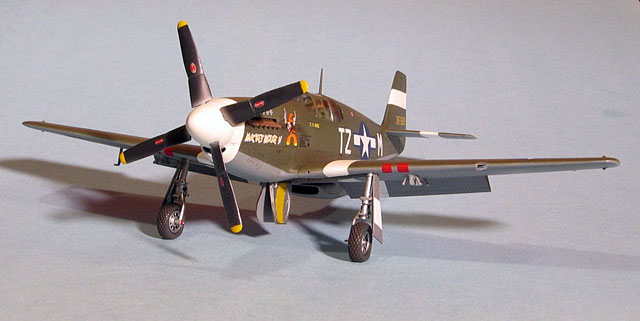
This proved to be an enjoyable project and I intend to build more
“planes from novels” in the future, all the time trying to keep it real.
Click
the thumbnails below to view larger images:
Model, Images and Text Copyright ©
2005 by Jonathan Strickland
Page Created 11 December, 2005
Last Updated
11 December, 2005
Back to
HyperScale Main Page |
Home
| What's New |
Features |
Gallery |
Reviews |
Reference |
Forum |
Search